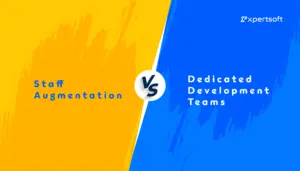Intro
Choosing the right tech stack is one of the most critical decisions you will make for your project. Whether you are developing a mobile app, web application, or enterprise software solution, the tech stack you choose will have a significant impact on your project’s scalability, performance, cost, and long-term viability. For business leaders—CEOs, CTOs, product managers—this decision goes beyond the technical considerations. It affects timelines, budgets, and, ultimately, the success of your product.
In this comprehensive guide, we will explore the different aspects of tech stacks, break down the decision-making process, and offer insights into the key factors to consider when choosing the right tech stack for your project.
What is a tech stack?
A tech stack refers to the combination of technologies—programming languages, frameworks, libraries, and tools—that are used to build a software product. It’s like the backbone of any digital solution, including web applications, mobile apps, or cloud platforms.
A typical tech stack includes both frontend (client-side) and backend (server-side) technologies, as well as databases and additional tools that support development, deployment, and maintenance. The choice of a tech stack can directly impact the development process, performance, scalability, and long-term maintainability of your product.
For business decision-makers, understanding the structure of a tech stack is critical for evaluating the trade-offs and making informed choices that align with business goals
Understanding the components of a tech stack
Every tech stack can be broken down into several key components. Let’s take a closer look at each part and its role in your project:
1. Frontend development
The frontend is the part of the application that users interact with. It is what they see and experience. For web applications, the frontend consists of technologies like HTML, CSS, and JavaScript. When developing modern, dynamic web apps, developers often use libraries or frameworks to streamline the process. Popular frontend frameworks include:
- React (JavaScript Library): Used for building fast, dynamic user interfaces. Companies like Facebook, Instagram, and Airbnb use React.
- Angular (Framework by Google): A full-featured frontend framework commonly used for enterprise-grade applications.
- Vue.js: A lightweight and flexible framework growing in popularity for both small and large-scale applications.
When selecting frontend technologies, the key considerations include user experience (UX), performance, and ease of maintenance.
2. Backend development
The backend is where the business logic, databases, and server-side operations occur. The backend ensures that data is processed, stored, and retrieved efficiently and communicates with the frontend to serve dynamic content. Popular backend technologies include:
- Node.js: A JavaScript runtime used to build fast, scalable server-side applications.
- Python (with Django or Flask): Known for readability and quick development cycles, Python is widely used in web and AI applications.
- Ruby on Rails: A framework known for developer happiness and rapid prototyping, used by companies like Shopify and GitHub.
- Java (Spring Boot): A mature, reliable backend solution commonly used in enterprise-grade applications.
- PHP (Laravel): Ideal for building dynamic websites and applications.
Backend development focuses on handling data, managing business logic, and ensuring the application can scale as user demands grow.
3. Databases
Databases are a crucial part of any tech stack, as they store the application’s data. There are two primary categories:
- Relational Databases (SQL): These databases, such as MySQL, PostgreSQL, and Microsoft SQL Server, store data in structured tables and are ideal for handling complex queries and relationships.
- Non-relational Databases (NoSQL): Databases like MongoDB, Cassandra, and Firebase are flexible and scalable, often used for big data and real-time applications.
Choosing the right database is essential for ensuring fast data retrieval, smooth user experiences, and scalability.
4. Development tools & version control
In addition to the programming languages and frameworks, developers use various tools to manage the project, track changes, and collaborate. Some essential tools include:
- Git: A version control system to track code changes and collaborate in teams.
- Jira: A project management tool commonly used for agile development.
- CI/CD Tools: Tools like Jenkins and CircleCI automate testing and deployment, ensuring continuous integration and delivery.
These tools improve productivity, ensure code quality, and accelerate time to market.
Key factors to consider when choosing a tech stack
Choosing the right tech stack can make or break your project. Here are the key factors business leaders should evaluate when selecting a tech stack:
1. Project requirements and business objectives
The most critical factor is aligning the tech stack with your project’s specific goals and business requirements. Different projects require different capabilities:
- Mobile Apps: If you’re building a mobile app, you’ll need to decide between native development (Swift for iOS, Kotlin for Android) or cross-platform frameworks like React Native or Flutter.
- Web Applications: For large-scale web applications, a full-stack JavaScript solution (e.g., MERN Stack: MongoDB, Express.js, React, Node.js) might be ideal.
- Enterprise Systems: For enterprise-grade solutions, Java (Spring Boot) or .NET are often favored for their stability and long-term support.
Action Tip:
Create a detailed list of technical requirements—such as real-time updates, scalability needs, and security features—and match these needs with the appropriate stack.
2. Scalability and growth
Scalability is critical, especially if you anticipate that your user base will grow. Some technologies handle scaling better than others. According to Google Cloud State of DevOps report high-performing teams using cloud-native architectures are “2.6 times more likely to meet their business performance goals.” This shows how adopting scalable technologies can directly contribute to project success.
- Microservices architecture (e.g., with Node.js or Java): Allows for scaling individual services independently, making it easier to grow without reworking the entire system.
- Cloud-Native Development: Leveraging cloud platforms like AWS, Google Cloud, or Azure can offer built-in scalability through services like auto-scaling, serverless computing (AWS Lambda), and database scaling.
Action Tip:
Choose a stack that will not only meet your current needs but will also support future growth without requiring massive overhauls.
3. Development time and cost
Some technologies are more developer-friendly, offering faster development cycles, while others might be more complex but provide long-term value. The JetBrains Developer Ecosystem Report 2023 notes that “63% of developers report that choosing a familiar tech stack increases productivity and speeds up project delivery.”
- Rapid Prototyping: Frameworks like Ruby on Rails and Laravel allow for quick MVP (Minimum Viable Product) development.
- Cross-platform Development: Solutions like React Native and Flutter allow for faster mobile app development since you only need one codebase for both Android and iOS.
Action Tip:
Evaluate the time to market and development costs associated with different tech stacks. In general, simpler, more efficient stacks lead to reduced development time and, consequently, lower costs.
4. Team expertise
Your development team’s expertise plays a crucial role in choosing a tech stack. It is more efficient to use tools that your team is already skilled in, rather than adopting new technologies that require extensive training. The Stack Overflow Developer Survey 2023 highlights how developer preferences play a crucial role: “JavaScript remains the most popular language, used by 67% of developers,” demonstrating the broad support and resources available for JavaScript-based stacks.
Action Tip:
Assess your team’s strengths and choose a tech stack that minimizes the learning curve, ensuring faster development and fewer mistakes.
5. Community support and ecosystem
A strong, active community around a particular technology ensures better support, more libraries, and continuous updates. Large, active communities also mean that it’s easier to find developers and resolve issues quickly.
Action Tip:
Opt for technologies with large, active communities to ensure ongoing support, quick issue resolution, and availability of additional resources like third-party libraries and plugins.
6. Security & compliance
Certain industries—such as healthcare, finance, and eCommerce—require strict adherence to security and compliance regulations, such as GDPR or HIPAA. Choosing a tech stack with built-in security features can save time and reduce risks.
Action Tip:
Ensure that the tech stack you choose offers robust security features and can comply with industry-specific regulations.
7. Integration with existing systems
If your project needs to integrate with legacy systems or existing third-party services (such as CRMs, ERPs, or payment gateways), your tech stack must be compatible with these platforms.
- Java and .NET: Both are well-known for their ability to integrate with complex enterprise systems.
- REST APIs and GraphQL: These protocols enable seamless integration between your software and external services.
Action Tip:
Choose a stack that offers good integration capabilities to reduce development time and complexity when dealing with existing systems.

Popular tech stacks for different use cases
Choosing the right tech stack depends largely on the type of application you’re building. Below are some of the most popular stacks based on specific project types:
1. Web Applications
- MEAN Stack (MongoDB, Express.js, Angular, Node.js): Ideal for building dynamic single-page applications (SPAs) that require fast, real-time data interactions.
- LAMP Stack (Linux, Apache, MySQL, PHP): A traditional, reliable stack for content-heavy websites and enterprise applications.
- MERN Stack (MongoDB, Express.js, React, Node.js): Often used for building fast, interactive web applications that handle a high number of users.
2. Mobile Apps
- React Native: Cross-platform framework used to build native-like mobile apps for both iOS and Android using JavaScript.
- Flutter: Google’s UI toolkit for building natively compiled mobile, web, and desktop applications from a single codebase using the Dart language.
- Native Android/iOS (Kotlin/Swift): For high-performance, native mobile applications, using Android and iOS-specific languages like Kotlin (Android) or Swift (iOS) is ideal.
3. Enterprise Software
- Java with Spring Boot: Known for its reliability, Java is widely used in enterprise-level applications that require high security, scalability, and performance.
- .NET Core: A cross-platform framework used for enterprise-grade applications with high scalability and integration needs.
4. Data-Intensive Applications
- Python with Django/Flask: Python is a go-to language for data-heavy applications and is often paired with Django or Flask for web development.
- Apache Hadoop or Apache Spark: For big data projects that require processing large volumes of data quickly.
- Kotlin or Scala (with Akka or Play frameworks): Functional programming languages that handle concurrency and parallel processing efficiently, ideal for real-time, data-driven applications.
Common mistakes business leaders make when choosing a tech stack
Choosing the wrong tech stack can lead to project delays, increased costs, and even failure. Here are common mistakes to avoid:
1. Choosing Based on Current Trends
Many decision-makers get swayed by the latest tech trends without considering if they align with their project’s needs. For example, while Blockchain and AI are hot trends, they may not be relevant to your application.
Solution:
Base your choice on project-specific requirements, not just on what’s trending.
2. Ignoring Team Expertise
Adopting a new language or framework that your development team is not familiar with can lead to slow progress and costly errors.
Solution:
Leverage your team’s current skills and build upon them.
3. Underestimating the Importance of Scalability
Choosing a tech stack that doesn’t easily scale can cause problems down the road when your user base grows or when you need to handle more complex tasks.
Solution:
Ensure the stack you choose can grow with your business.
4. Overlooking Security Requirements
Security should be a top priority for any business dealing with sensitive data. Choosing a stack with poor security features or failing to integrate proper security measures can lead to catastrophic consequences.
Solution:
Prioritize security from the start and select technologies that offer built-in protections.
The role of emerging technologies in tech stack decisions
In 2024, several emerging technologies are transforming how businesses approach tech stack decisions. Let’s explore some of the most impactful trends:
1. AI and Machine Learning
AI is becoming increasingly integrated into applications, from chatbots to predictive analytics. Choosing a tech stack with strong AI/ML libraries, such as Python with TensorFlow or PyTorch, can give your business a competitive edge.
3. Internet of Things (IoT)
Building IoT systems requires a tech stack that can handle real-time data processing, device integration, and connectivity. Node.js, Python, and platforms like AWS IoT are commonly used for IoT applications.
2. Blockchain
For industries requiring decentralized solutions or secure, transparent ledgers, Blockchain technology (with platforms like Ethereum or Hyperledger) is gaining traction.
4. Serverless Computing
Serverless architectures, using services like AWS Lambda, are becoming popular for reducing infrastructure costs and simplifying scaling. They are ideal for applications that experience unpredictable traffic patterns or need to scale rapidly.
Real-World Examples: How Leading Companies Select Their Tech Stack
Netflix: The power of Microservices
Netflix uses a microservices architecture built on top of Java and Node.js to handle its massive user base. By breaking down its application into small, independent services, Netflix can deploy updates faster and scale more efficiently.
Spotify: Python for Data-Intensive Applications
Spotify uses Python for its backend, primarily because of its data-handling capabilities. With millions of songs and users, Spotify relies on Python for real-time data processing and machine learning algorithms.
Airbnb: Full-Stack JavaScript
Airbnb leverages the MERN Stack (MongoDB, Express, React, Node.js) for its web application, ensuring that both the frontend and backend share the same programming language (JavaScript), simplifying development and maintenance.
How to future-proof your tech stack
Future-proofing your tech stack ensures that your project can grow and adapt to new requirements and challenges. Here’s how to plan for the future:
- Focus on Modular Architectures: Using microservices or modular components allows you to update individual parts of your system without affecting the entire application.
- Choose Open-Source Technologies: Open-source frameworks and tools are more likely to be supported long-term by a community, ensuring longevity.
- Prioritize Scalability and Performance: Opt for technologies that allow for easy scaling, such as cloud-native solutions or frameworks that support horizontal scaling.
Finally. choosing.
Choosing the right tech stack is a strategic decision that requires careful consideration of your project’s needs, business goals, and future growth plans.
By evaluating the factors discussed in this guide—such as project requirements, scalability, team expertise, security, and emerging technologies—you can confidently choose a tech stack that will drive your business forward.
Need help choosing the right tech stack for your project? Contact us for a consultation, and our team of experts will guide you in selecting the best technologies for your specific needs.



